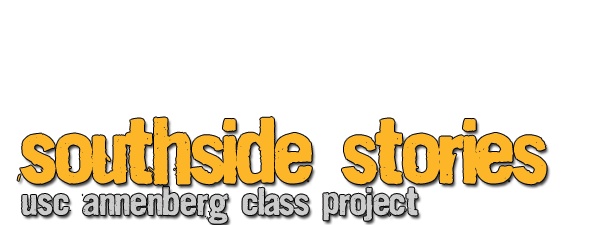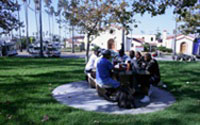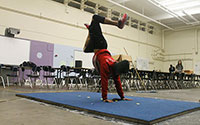Regina Clifton refuses to let her scarring past define who she is today, although she will never forget the events that forced her to grow up young.
Meet the people who hang out in or pass through Chesterfield Square Park, one of South L.A.’s most vibrant community spaces, in this interactive multimedia feature.
The Vermont Square neighborhood touches on a great deal of history. Click here to read about the community’s architectural landmarks and watch a visual representation of how the community has changed over the years.
"I'm planning to apply to USC and I was just wondering [about] the neighborhood around USC, I heard it wasn't that great."
This post by "confused_junior" in 2006 sparked an online dialogue about the quality of the neighborhood surrounding the University of Southern California. The conversation continued for years and in the more recent posts, many contributors point out that the community has changed since 2006, largely due to USC’s investment.
In the past two years, violent crime has decreased by 27 percent in the immediate area around USC, according to LAPD Chief Charlie Beck. This trend was overshadowed by two traumatic incidents this year involving USC.
Last April, two USC engineering students were fatally shot a few blocks north of campus. Months later, another shooting took place on campus at a Halloween party. Following the incidents, USC increased its efforts to make the neighborhood a safer place.
But the university’s interest in the community goes beyond merely ensuring the safety of its students.
South of campus, locals can see the school’s influence -- and it has nothing to do with the additional security officers.
Daniel E. Brown, 85, has lived on W. 40th Place, just south of USC, for 54 years. He bought his house shortly after marrying his wife.
"I have never found another neighborhood that I like to live in," Brown said. "From the day I bought this house, I've always been getting calls, 'do you want to sell the house?', but I have never found another neighborhood."
Brown’s kids have moved out, and his wife passed away 12 years ago. Now, the neighborhood is his support system.
"We all get along like one big happy family," Brown said of his neighbors. "They all look out for me. And I watch out for them."
As one of the longest residents in the neighborhood, Brown has seen the community evolve as people come and go. He’s also seen a shift in crime.
"It’s real quiet. Very safe," Brown said. "The police station is down the street, and the police go through here - four or five on the bicycles and the cars go through here all day long. So we don’t have any problems."
William Brown, 23 - no relation to Daniel - has dealt with crime first hand.
"It’s been kind of dangerous. I’ve been shot at two times," William said. The second time, William was hit, and he now has a noticeable scar on his neck. "Wrong place at the wrong time I guess. I was outside basically. That’s how it is. If you’re outside, somebody decides to shoot you, there ain’t nothing you can really do."
He has been living in the Vermont Harbor neighborhood since he was born. When he was younger, his dad was sent to jail on a life sentence, and his mom moved to Vegas. Now, William lives with his grandmother off of Budlong Ave., south of USC.
"I’d say it’s a good place to live," William said in spite of his shooting experiences. "I like it. I like it here better than anywhere else I’ve been at in California.

The sun sets in Vermont Harbor to the sound ofhelicopters and church bell chimes.
"When I was growing up, there was way more crime. So now it’s down," he continued. "I think [the community] is going more up. Everything is going more upscale because it’s close to USC."
But USC hasn’t had this impact by just increasing officer patrols or adding extra yellow-jacketed security ambassadors on street corners. The school’s investment goes far beyond simply reducing crime.
USC is Los Angeles’ largest private employer. According to a 2008 study commissioned by the school, USC generates $4.9 billion annually - likely more now - in economic activity in the Los Angeles region and beyond. The report found that every dollar spent by USC in Los Angeles County equated to an additional 63 cents of output elsewhere in the regional economy.
Similarly, the university’s Good Neighbors Campaign, a fundraising program launched in 1994, has collected over $14 million to support community organizations.
University-community partnership programs use the GNC grants to, "put children on the pathway to college, make streets safer for families, and offer activities and programs aimed at improving the health and well-being of residents in the neighborhoods surrounding USC’s campuses," states USC’s Communities website.
These programs likely do more to reduce crime than increased neighborhood security. Giving children productive outlets makes them less likely to fall into bad situations, and offering gainful employment to locals enables them to cover the cost of living in L.A. Reduced crime, strong schools and work opportunities all help to elevate the South L.A. "ghetto" to a up-and-coming neighborhood.
"USC contributes great," said resident Shoa Endl. "Small kids are growing up and feeling the spirit of being a Trojan...Some jobs, also they’re creating. They’re expanding. I see the spirit of expanding in terms of benefitting the community."
Endl’s wife, Haimanot Haile added, "USC is growing faster right now...A lot of people I know see the USC area is very beautiful...Their mind is changing, not like before."
The couple, who moved to Vermont Harbor in 2010, said the university’s investment has increased the value of living in the neighborhood, and they recommend the area to current homebuyers.
But some see USC’s expansion as overtaking the community.
The school’s planned $1 billion redevelopment of the University Village shopping center has been met with criticism from local vendors who claim they are being edged out. The project is intended, however, to make housing more available and affordable to USC students and locals alike.
"In recent years, as the population of undergraduates from out of state has grown, students have overwhelmed the university's supply of campus housing and descended on the neighborhood, where opportunistic property owners jacked up rents that students could pay and displaced families that couldn't afford them," the Los Angeles Times stated in a piece about the project.
Called the Village at USC, the new center will provide 4,000 more beds for students. Moreover, the university will give $20 million to a city fund for creating and maintaining affordable housing in the area surrounding USC.
The project will also generate 12,000 new jobs -- 4,000 construction-related and 8,000 permanent. USC has committed to hiring 30 percent of the workforce for the Village from within a five-mile radius of the campus.
South Central resident Olivia Modesto is still unsure about the project. "It’s bad for the people that have been there, but I think it’s a good thing because they may open up more stores or markets or businesses that we would need. I’m 50-50 I guess."
Most in Vermont Harbor do not feel threatened by USC's expansion -- in part because the school's acquisition focus is to the north, but also because the school's influence has been very positive. "If USC tried to do improving in the surrounding area," Endl said, "it would be supported really."
From increasing security to creating new housing to funding community programs, USC’s investment in the surrounding area is extensive. Despite mild criticism, the university is slowly changing what it means to live in the "ghetto" of South Central.




